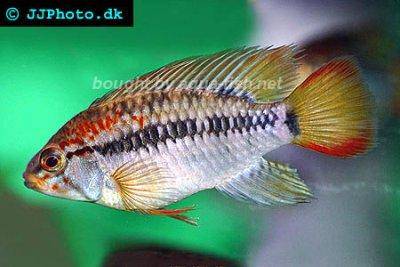Macmaster’s dwarf cichlid - Apistogramma macmasteri
Scientific name: Apistogramma macmasteri
Common name: Macmaster’s dwarf cichlid
Family: Cichlidae
Usual size in fish tanks: 5 - 6 cm (1.97 - 2.36 inch)
014
Recommended pH range: 6.4 - 7.1
Recommended water hardness: 4 - 14°N (71.43 - 250ppm)
0°C 32°F30°C 86°F
Recommended temperature range: 23 - 28 °C (73.4 - 82.4°F)
The way how these fish reproduce: Spawning
Where the species comes from: South America
Temperament to its own species: peaceful
Temperament toward other fish species: peaceful
Usual place in the tank: Middle levels
Short Description
The Macmaster’s Dwarf Cichlid (Apistogramma macmasteri) is a colorful and peaceful cichlid species native to South America. Known for their vibrant hues and fascinating behaviors, they thrive in planted aquariums with soft, acidic water. These cichlids are perfect for peaceful South American community setups but require careful attention to water quality, especially if wild-caught. Their manageable size and striking appearance make them a favorite among aquarists.
Origin
Apistogramma macmasteri is native to South America, inhabiting the clear water streams and rivers. These environments are rich in vegetation and provide plenty of hiding spots, which influence their natural behaviors and preferences in captivity.
Tank Requirements
A tank of at least 60 liters (15 gallons) is recommended for a single pair or trio. Maintain water temperatures between 23-28°C (73.4-82.4°F), a pH range of 6.4-7.1, and water hardness of 4-14°N (71.43-250 ppm). Use a sandy substrate and add rocks, driftwood, and plants to create hiding places and territorial boundaries. Floating plants can help dim the lighting and create a more secure environment. Perform regular water changes of 10% to keep water conditions stable and balanced.
Food and Feeding
Macmaster’s Dwarf Cichlids are omnivorous but prefer live or frozen foods. Offer high-quality flakes or small cichlid pellets as a staple diet, supplemented with bloodworms, brine shrimp, white worms, and mysis shrimp. A varied diet will enhance their coloration and overall health.
Compatibility
This species is peaceful but may become territorial during breeding. Suitable tankmates include small, non-aggressive fish such as tetras, rasboras, and Corydoras catfish. Avoid housing them with other Apistogramma species to reduce competition and potential aggression.
Sexing
Males are larger and exhibit more vibrant coloration, with a rounded caudal fin edged in red. Females are smaller and less colorful, making sexing relatively straightforward as the fish mature.
Breeding
Breeding Apistogramma macmasteri requires clean, soft, and acidic water. They are cave spawners, so provide plenty of caves using upturned plant pots or similar structures. One male can be kept with multiple females in a breeding setup. The female guards the eggs, while the male defends the territory. Fry become free-swimming after 7 days and can be fed newly hatched brine shrimp. During spawning, the female may become aggressive toward the male; if this aggression becomes excessive, consider removing the male to ensure the female’s and fry’s safety.
Lifespan
With proper care, the expected lifespan of Macmaster’s Dwarf Cichlids is 3-5 years. Maintaining stable water parameters, a nutritious diet, and a stress-free environment are essential for their longevity.
Pictures
Bought by aqua-fish.net from jjphoto.dk.







 Thread-finned
Thread-finned  Acara
Acara  Yellow
Yellow  Patrick's
Patrick's  Blue
Blue  Green
Green  Acara
Acara  White
White  Compressed
Compressed  Pastel
Pastel  Midas
Midas  Red
Red  Bluemouth
Bluemouth  False
False  African
African  Agassiz's
Agassiz's  Banded
Banded  Yellow
Yellow  Cockatoo
Cockatoo  Blue
Blue  Blackstripe
Blackstripe  Highfin
Highfin  Redstripe
Redstripe  Threadfinned
Threadfinned  Panda
Panda  Norbert’s
Norbert’s  Blue
Blue  Thin-line
Thin-line  Three-striped
Three-striped  Viejita
Viejita  Flier
Flier  Archocentrus
Archocentrus  Convict
Convict  Seven
Seven  Spiny
Spiny  Oscar
Oscar  Sunshine
Sunshine  Chitande
Chitande  Firebird
Firebird  Midnight
Midnight  Lake
Lake  Sunshine
Sunshine  Aulonocara
Aulonocara  Nyasa
Nyasa  Ruby
Ruby  Grants
Grants  Aulonocranus
Aulonocranus  Chameleon
Chameleon  Benitochromis
Benitochromis  Orinoco
Orinoco  Yellow
Yellow  Brichard’s
Brichard’s  Guenther’s
Guenther’s  Southern
Southern  Cichla
Cichla  Peacock
Peacock  Chiseltooth
Chiseltooth  Bolivian
Bolivian  Red
Red  Many-pointed
Many-pointed  Jack
Jack  Red
Red  Three
Three  Keyhole
Keyhole  Azureus
Azureus  Red
Red  Jackson’s
Jackson’s  Crenicichla
Crenicichla  Honduran
Honduran  Blue-eye
Blue-eye  Afra
Afra  Frontosa
Frontosa  Slender
Slender  Malawi
Malawi  Chequerboard
Chequerboard  Checkerboard
Checkerboard  Malawi
Malawi  Ectodus
Ectodus  Tanganyika
Tanganyika  Canara
Canara  Green
Green  Rostratus
Rostratus  Pearl
Pearl  Geophagus
Geophagus  Yellowhump
Yellowhump  Suriname
Suriname  Redhump
Redhump  Red
Red  Dority’s
Dority’s  Argentine
Argentine  Burton’s
Burton’s  Victoria
Victoria  Haplochromis
Haplochromis  Jewel
Jewel  Banded
Banded  Lifalili
Lifalili  Lowland
Lowland  Texas
Texas  Pantano
Pantano  Severum
Severum  Banded
Banded  Severum
Severum  Rainbow
Rainbow  Parrot
Parrot  Chocolate
Chocolate  Brown
Brown  Marlieri
Marlieri  Golden
Golden  Striped
Striped  Masked
Masked  Konye
Konye  Blue
Blue  Trewavas
Trewavas  Electric
Electric  Dwarf
Dwarf  Redbreast
Redbreast  Lamprologus
Lamprologus  Gold
Gold  Greenface
Greenface  Mayan
Mayan  Aurora
Aurora  Blue
Blue  William’s
William’s  Zebra
Zebra  Malawi
Malawi  Blue
Blue  Blue
Blue  Mbuna
Mbuna  Parallel
Parallel  Purple
Purple  Flag
Flag  Bolivian
Bolivian  Ram
Ram  Basket
Basket  Haitian
Haitian  Zebra
Zebra  Striped
Striped  Neolamprologus
Neolamprologus  Brevis
Brevis  Fairy
Fairy  Neolamprologus
Neolamprologus  Cylindricus
Cylindricus  Hecq’s
Hecq’s  Neolamprologus
Neolamprologus  Lemon
Lemon  Mustax
Mustax  Daffodil
Daffodil  Six-bar
Six-bar  Five-bar
Five-bar  Marbled
Marbled  Giraffe
Giraffe  Blue
Blue  Sulphurhead
Sulphurhead  Wolf
Wolf  Jaguar
Jaguar  Blue
Blue  Marakeli
Marakeli  Madagascar
Madagascar  Pinstripe
Pinstripe  Pelmatochromis
Pelmatochromis  Kribensis
Kribensis  Striped
Striped  Red
Red  Deepwater
Deepwater  Fenestratus
Fenestratus  Nichols’
Nichols’  Southern
Southern  Bumble
Bumble  Demason’s
Demason’s  Slender
Slender  Red
Red  Mbuna
Mbuna  Malawi
Malawi  Kenyi
Kenyi  Powder
Powder  Altum
Altum  Angelfish
Angelfish  Angelfish
Angelfish  East
East  Juba
Juba  Earth
Earth  Electric
Electric  Azure
Azure  Lionhead
Lionhead  Discus
Discus  Blue
Blue  Red
Red  Zebra
Zebra  Brichard’s
Brichard’s  Blue
Blue  Firemouth
Firemouth  Zebra
Zebra  Yellow
Yellow  Blue
Blue  Dwarf
Dwarf  Blunthead
Blunthead  The
The  White
White  Twoband
Twoband  Fenestratus
Fenestratus  Window
Window  Tailbar
Tailbar  Black
Black  Redhead
Redhead  Oaxaca
Oaxaca  Xenotilapia
Xenotilapia